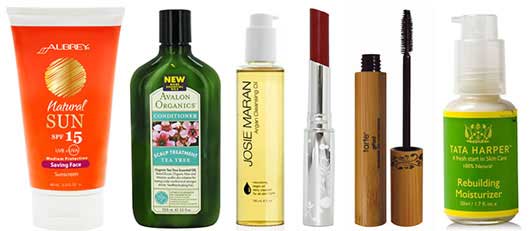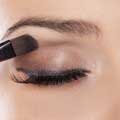
For years, we’ve been exposed to harsh chemicals without even noticing. And no, I don’t mean those you use to clean your kitchen. There are harmful ingredients in your cosmetics, and research has shown that your beauty routine could lead to potentially serious health issues. The worst part is that we, as consumers, don’t realize just how harmful these products can be. Scary, isn’t it?
BE AWARE
Your skin absorbs almost everything you put on it, so start a new habit: read labels carefully. It takes time to understand some of the terminology on them but according to Debra Jaliman, M.D. and author of Skin Rules: Trade Secrets from a Top New York Dermatologist, “most harmful ingredients are easy to spot.”
Susie Wang, founder of Purity Cosmetics and 100 Percent Pure, a natural and organic beauty line, adds that “the first few ingredients listed will usually be what make up the majority of the formula and of course, steer clear from those you’ve never heard of or can’t pronounce.”
Still wondering what to avoid? Here’s a simple list of what you should be wary of, according to the experts.
- Alcohol: It causes dryness, which can strip your skin of its moisture. Alcohol is used to appeal to our sense of smell; yet synthetic fragrances can often lead to headaches, nausea and allergic reactions. If you suffer from sensitive skin, this ingredient can be your worst nightmare.
- Parabens: Are known to extend the shelf life of products; however they are also known to have hormone-disrupting effects.
- Formaldehyde: This newly popular ingredient, found in beauty products and new hair treatments, is regulated by OSHA (Occupational Safety and Health Administration) as a cancer-causing substance.
- Triclosan: Found in most anti-bacterial items; although it does work to kill bacteria, its formula can be risky to human health, not to mention the environment.
- Phthalates: Known as hormone-disrupting chemicals that threaten reproductive health, they are added to many cosmetics and personal care products including scented creams, shampoo, nail polish, and hair spray.
- Retinyl Palmitate: Like retinol, retinyl palmitate is safe and effective in night creams but during the day, it breaks down in sunlight to form free radicals that can harm cells and possibly lead to cancer. Avoid sunscreens with this ingredient.
- Zinc Oxide Nanoparticles: Studies are beginning to show that people whose sunscreens contain zinc nanoparticles have increased levels of zinc in their blood.
Dr. Jaliman explains that “when sunscreens go on white, it means that they contain micronized zinc oxide or titanium dioxide, which is safe. When they come out clear from the tube, the manufacturer has used nanoparticles that are many times smaller. This is one area where big truly is better.” Avobenzone, Benzphenone, Ethoxycinnamate and PABA, found in sunscreens as well, are believed to damage DNA. Choosing the right one is key.
- Dihydroxyacetone: Also known as DHA or glycerone, this is the primary ingredient on self-tanner products. If inhaled or ingested, there could be potential health risks such as DNA damage and cancer. “DHA has been approved for the body, but not for inhaling,” says celebrity makeup artist Kimara Ahnert. “Always opt for a self-tanner that uses an aroma guard. Not only does it prevent the unpleasant self-tanning smell, but it prevents negative effects of DHA.”
- Sodium Lauryl Sulfate & Sodium Laureth Sulfate: This very drying and harsh component is often found in shampoos…and in dishwasher soaps and floor cleaners. It can damage your immune system and cause eye irritation, dry scalp, skin rashes, and even death. My advice? If your shampoo makes lots of foam, run—don’t walk—away from it.
- DEA, MEA & TREA: These are all hormone disruptors and cause adverse skin reactions. It is easily absorbed by our bodies but after long exposure, it increases the risk of liver and kidney cancer. This trio is usually found in soaps and cleansers—anything that foams.
And the list can go on and on. Effects can vary from person to person, but you have to admit this is a little disturbing. After all, we have all been exposed to them for as far as we can remember. On the bright side, Dr. Marina Peredo, M.D., F.A.A.D., nationally recognized board certified dermatologist with more than 20 years of experience, thinks “you can get just as effective results without harsh ingredients.”
Read Related: Be Beautiful and Eco-Friendly

NATURAL IS NOT ALWAYS BETTER
“Natural doesn’t necessarily mean better and what may be beneficial to you may cause a reaction in someone else,” says Susie Wang. Even organic products can cause negative side effects, depending on the user.
Organic and natural components have their ups and downs. Wang explains that “there aren’t really any natural ingredients that cause harm, but mineral oil can be bad for the skin because it coats the skin like plastic, keeping the skin from breathing and releasing toxins.” Dr. Peredo sums it up: “the biggest challenge with natural or organic formulas is the stability because they go bad much faster.”
So, while your chemical-laden products may have a longer shelf life, they contain harmful ingredients. My choice is to go organic, and replace cosmetics a bit more frequently.












Leave a Reply
Want to join the discussion?Feel free to contribute!